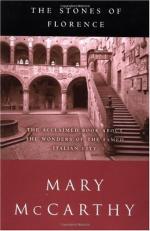
|
| Name: _________________________ | Period: ___________________ |
This test consists of 5 multiple choice questions, 5 short answer questions, and 10 short essay questions.
Multiple Choice Questions
1. Who wrote a sonnet denouncing Pistoia?
(a) Machiavelli.
(b) Michelangelo.
(c) Donatello.
(d) Dante.
2. When did the battle of Pistoria take place?
(a) 62 B.C.
(b) 722 B.C.
(c) A.D. 66.
(d) 1 B.C.
3. As represented in the statue at the Bargello, what weapon does Saint George conspicuously not carry?
(a) A whip.
(b) A sword.
(c) A quarterstaff.
(d) A dagger.
4. As mentioned in Chapter 3, what does the surname "Bevisangue" mean?
(a) "Blood-drinker."
(b) "Goldenhearted."
(c) "Cold-blooded."
(d) "Ruthless."
5. Who wrote the poem "Hermaphroditus"?
(a) Donatello.
(b) Dante.
(c) Beccadelli.
(d) Daniel DeFoe.
Short Answer Questions
1. According to the information provided in the first paragraph of Chapter 2, who attacked Fiesole?
2. What is Donatello's statue of John the Baptist as a boy called?
3. Who is the person mentioned in Chapter 3 who did not exact revenge from someone he came across on Good Friday?
4. According to the author, who is the only person who can observe Florence well?
5. Where did Buondelmonte de' Buondelmonti, the bridegroom mentioned in Chapter 2, die?
Short Essay Questions
1. Why does the author describe Florence as a "manly town" in Chapter 1?
2. Describe a legend that is attached to one of the churches mentioned in Chapter 3.
3. Compare Pistoia in the medieval period to Pistoia in the twentieth century.
4. Describe Michelangelo's personality.
5. Describe the weather in Florence in summer.
6. Describe the typical interior and exterior of Florence palaces.
7. Why is sculpture part of "the very fabric of the city" of Florence, as the author asserts in Chapter 2?
8. Summarize the story of the founding of Florence, as discussed in the beginning of Chapter 2.
9. Describe the architectural difference between Guelph and Ghibelline cities.
10. For what reason is Saint Giovanni Gualberto primarily remembered?
|
This section contains 687 words (approx. 3 pages at 300 words per page) |

|




